MAZDA MODEL 3 5-DOOR 2016 Owners Manual
Manufacturer: MAZDA, Model Year: 2016, Model line: MODEL 3 5-DOOR, Model: MAZDA MODEL 3 5-DOOR 2016Pages: 598, PDF Size: 30.13 MB
Page 211 of 598
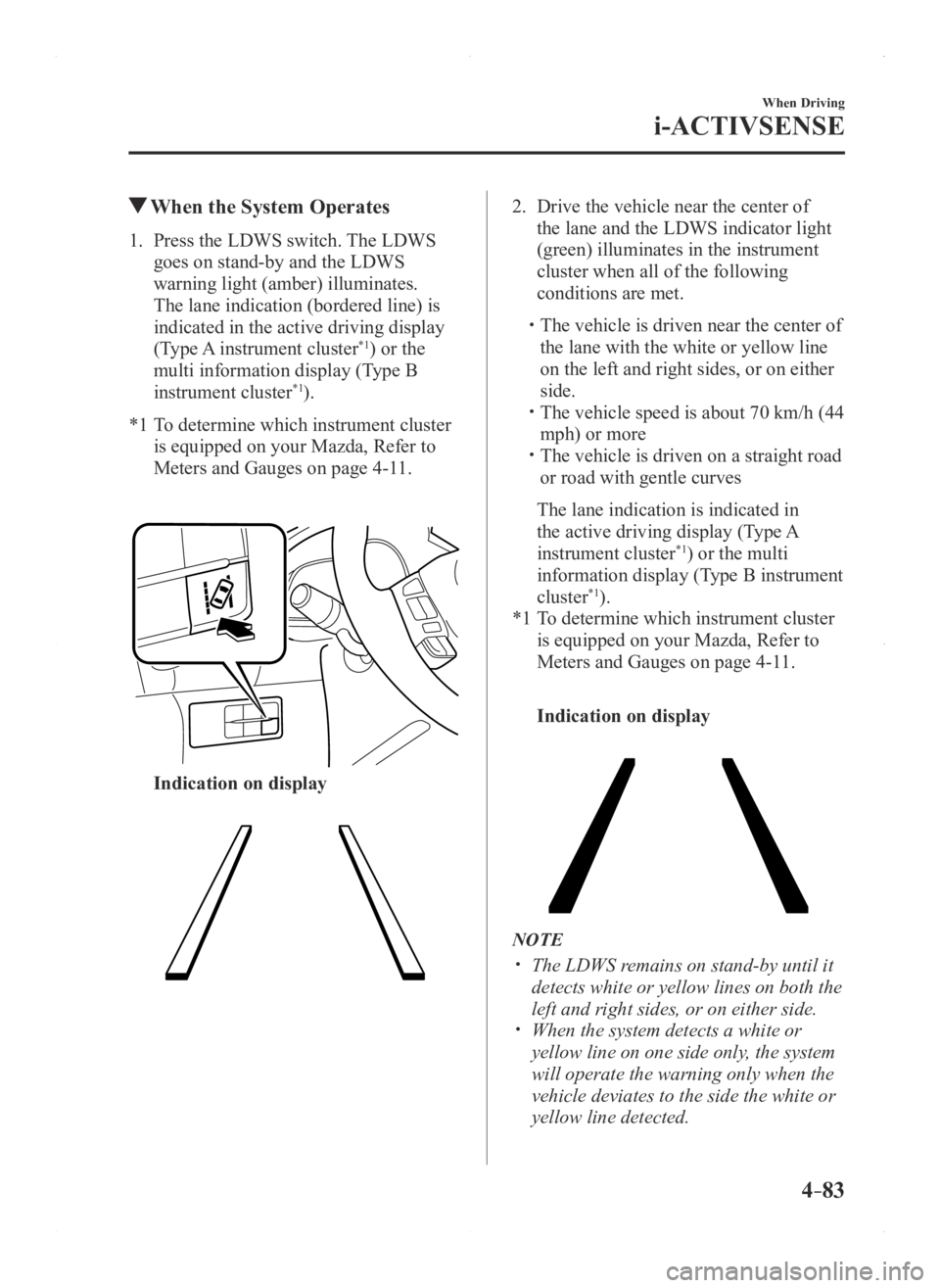
4–83
When Driving
i-ACTIVSENSE
When the System Operates
1. Press the LDWS switch. The LDWS
goes on stand-by and the LDWS
warning light (amber) illuminates.
The lane indication (bordered line) is
indicated in the active driving display
(Type A instrument cluster
*1) or the
multi information display (Type B
instrument cluster
*1).
*1 To determine which instrument cluster
is equipped on your Mazda, Refer to
Meters and Gauges on page 4-11.
Indication on display
2. Drive the vehicle near the center of
the lane and the LDWS indicator light
(green) illuminates in the instrument
cluster when all of the following
conditions are met.
The vehicle is driven near the center of
the lane with the white or yellow line
on the left and right sides, or on either
side.
The vehicle speed is about 70 km/h (44
mph) or more The vehicle is driven on a straight road
or road with gentle curves
The lane indication is indicated in
the active driving display (Type A
instrument cluster*1) or the multi
information display (Type B instrument
cluster
*1).
*1 To determine which instrument cluster
is equipped on your Mazda, Refer to
Meters and Gauges on page 4-11.
Indication on display
NOTE
The LDWS remains on stand-by until it
detects white or yellow lines on both the
left and right sides, or on either side.
When the system detects a white or
yellow line on one side only, the system
will operate the warning only when the
vehicle deviates to the side the white or
yellow line detected.
Mazda3_8FA4-EA-15G_Edition1.indb 832015/05/11 14:01:02
Page 212 of 598
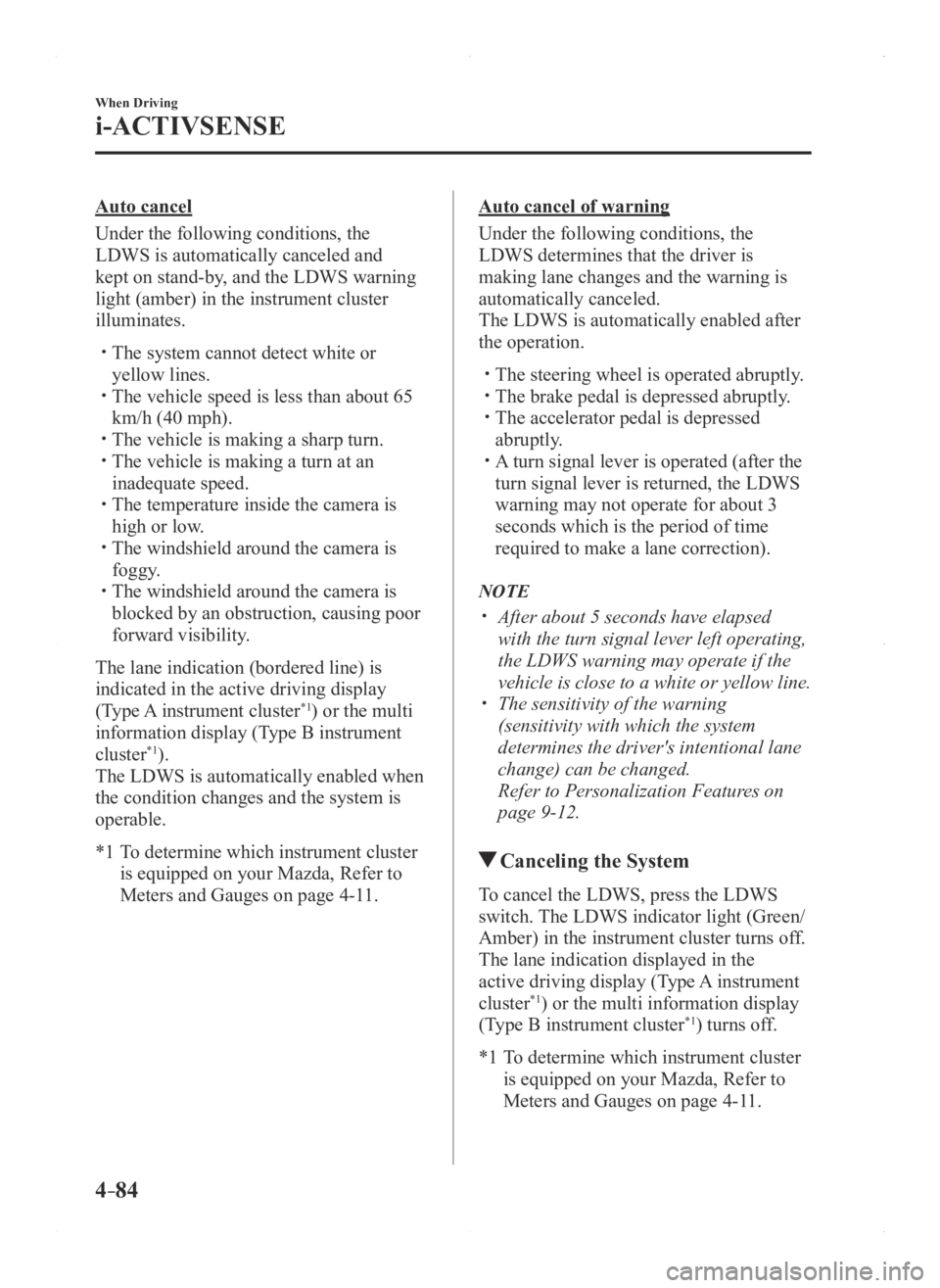
4–84
When Driving
i-ACTIVSENSE
Auto cancel
Under the following conditions, the
LDWS is automatically canceled and
kept on stand-by, and the LDWS warning
light (amber) in the instrument cluster
illuminates.
The system cannot detect white or
yellow lines. The vehicle speed is less than about 65
km/h (40 mph). The vehicle is making a sharp turn. The vehicle is making a turn at an
inadequate speed. The temperature inside the camera is
high or low. The windshield around the camera is
foggy. The windshield around the camera is
blocked by an obstruction, causing poor
forward visibility.
The lane indication (bordered line) is
indicated in the active driving display
(Type A instrument cluster
*1) or the multi
information display (Type B instrument
cluster
*1).
The LDWS is automatically enabled when
the condition changes and the system is
operable.
*1 To determine which instrument cluster
is equipped on your Mazda, Refer to
Meters and Gauges on page 4-11.
Auto cancel of warning
Under the following conditions, the
LDWS determines that the driver is
making lane changes and the warning is
automatically canceled.
The LDWS is automatically enabled after
the operation.
The steering wheel is operated abruptly . The brake pedal is depressed abruptly. The accelerator pedal is depressed
abruptly. A turn signal lever is operated (after the
turn signal lever is returned, the LDWS
warning may not operate for about 3
seconds which is the period of time
required to make a lane correction).
NOTE
After about 5 seconds have elapsed
with the turn signal lever left operating,
the LDWS warning may operate if the
vehicle is close to a white or yellow line.
The sensitivity of the warning
(sensitivity with which the system
determines the driver's intentional lane
change) can be changed.
Refer to Personalization Features on
page 9-12.
Canceling the System
To cancel the LDWS, press the LDWS
switch. The LDWS indicator light (Green/
Amber) in the instrument cluster turns off.
The lane indication displayed in the
active driving display (Type A instrument
cluster
*1) or the multi information display
(Type B instrument cluster*1) turns off.
*1 To determine which instrument cluster
is equipped on your Mazda, Refer to
Meters and Gauges on page 4-11.
Mazda3_8FA4-EA-15G_Edition1.indb 842015/05/11 14:01:02
Page 213 of 598
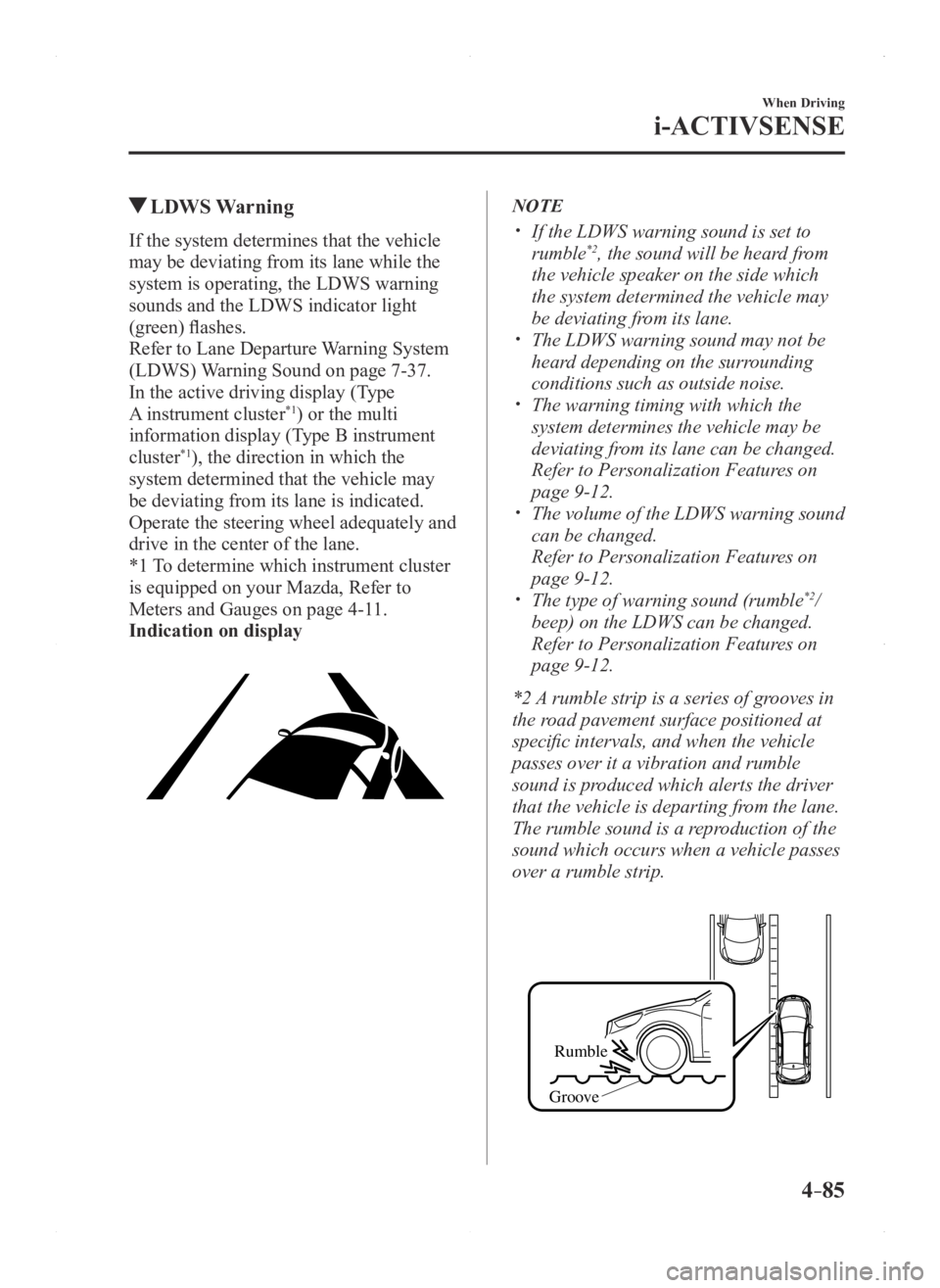
4–85
When Driving
i-ACTIVSENSE
LDWS Warning
If the system determines that the vehicle
may be deviating from its lane while the
system is operating, the LDWS warning
sounds and the LDWS indicator light
(green) flashes.
Refer to Lane Departure Warning System
(LDWS) Warning Sound on page 7-37.
In the active driving display (Type
A instrument cluster
*1) or the multi
information display (Type B instrument
cluster
*1), the direction in which the
system determined that the vehicle may
be deviating from its lane is indicated.
Operate the steering wheel adequately and
drive in the center of the lane.
*1 To determine which instrument cluster
is equipped on your Mazda, Refer to
Meters and Gauges on page 4-11.
Indication on display
NOTE
If the LDWS warning sound is set to
rumble*2, the sound will be heard from
the vehicle speaker on the side which
the system determined the vehicle may
be deviating from its lane.
The LDWS warning sound may not be
heard depending on the surrounding
conditions such as outside noise.
The warning timing with which the
system determines the vehicle may be
deviating from its lane can be changed.
Refer to Personalization Featur es on
page 9-12. The volume of the LDWS warning sound
can be changed.
Refer to Personalization Features on
page 9-12. The type of warning sound (rumble*2/
beep) on the LDWS can be changed.
Refer to Personalization Featur es on
page 9-12.
*2 A rumble strip is a series of grooves in
the road pavement surface positioned at
specific intervals, and when the vehicle
passes over it a vibration and rumble
sound is produced which alerts the driver
that the vehicle is departing from the lane.
The rumble sound is a reproduction of the
sound which occurs when a vehicle passes
over a rumble strip.
Rumble
Groove
Mazda3_8FA4-EA-15G_Edition1.indb 852015/05/11 14:01:02
Page 214 of 598
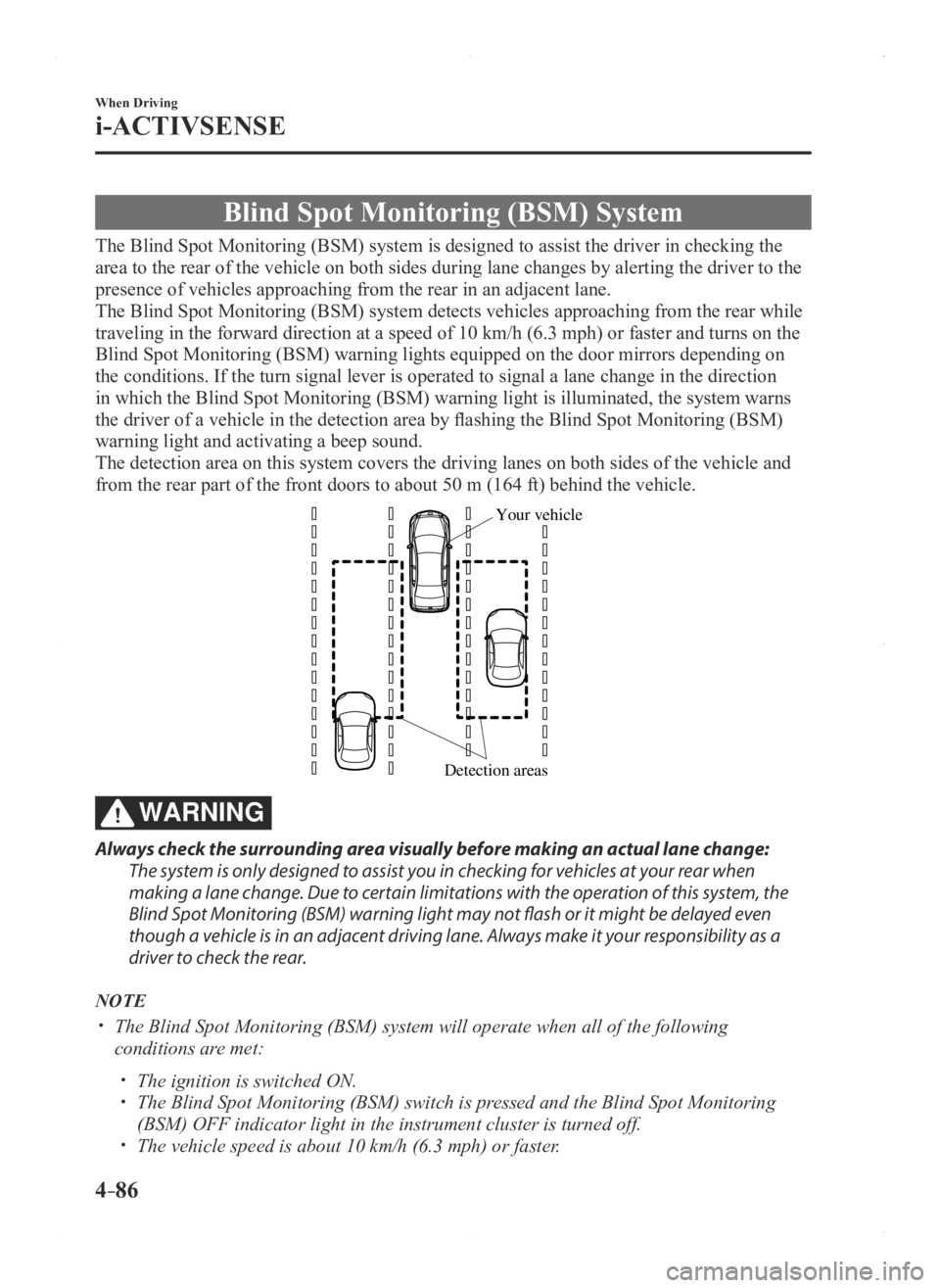
4–86
When Driving
i-ACTIVSENSE
Blind Spot Monitoring (BSM) System
The Blind Spot Monitoring (BSM) system is designed to assist the driver in checking the
area to the rear of the vehicle on both sides during lane changes by ale\
rting the driver to the
presence of vehicles approaching from the rear in an adjacent lane.
The Blind Spot Monitoring (BSM) system detects vehicles approaching from the rear while
traveling in the forward direction at a speed of 10 km/h (6.3 mph) or \
faster and turns on the
Blind Spot Monitoring (BSM) warning lights equipped on the door mirrors depending on
the conditions. If the turn signal lever is operated to signal a lane ch\
ange in the direction
in which the Blind Spot Monitoring (BSM) warning light is illuminated, the system warns
the driver of a vehicle in the detection area by flashing the Blind Spot Monitoring (BSM)
warning light and activating a beep sound.
The detection area on this system covers the driving lanes on both sides\
of the vehicle and
from the rear part of the front doors to about 50 m (164 ft) behind th\
e vehicle.
Detection areas
Your vehicle
WARNING
Always check the surrounding area visually before making an actual lane change:
The system is only designed to assist you in checking for vehicles at your rear when
making a lane change. Due to certain limitations with the operation of this system, the
Blind Spot Monitoring (BSM) warning light may not flash or it might be delayed even
though a vehicle is in an adjacent driving lane. Always make it your responsibility as a
driver to check the rear.
NOTE
The Blind Spot Monitoring (BSM) system will operate when all of the fo\
llowing
conditions are met:
The ignition is switched ON. The Blind Spot Monitoring (BSM) switch is pressed and the Blind Spot Monitoring
(BSM) OFF indicator light in the instrument cluster is turned off. The vehicle speed is about 10 km/h (6.3 mph) or faster .
Mazda3_8FA4-EA-15G_Edition1.indb 862015/05/11 14:01:02
Page 215 of 598
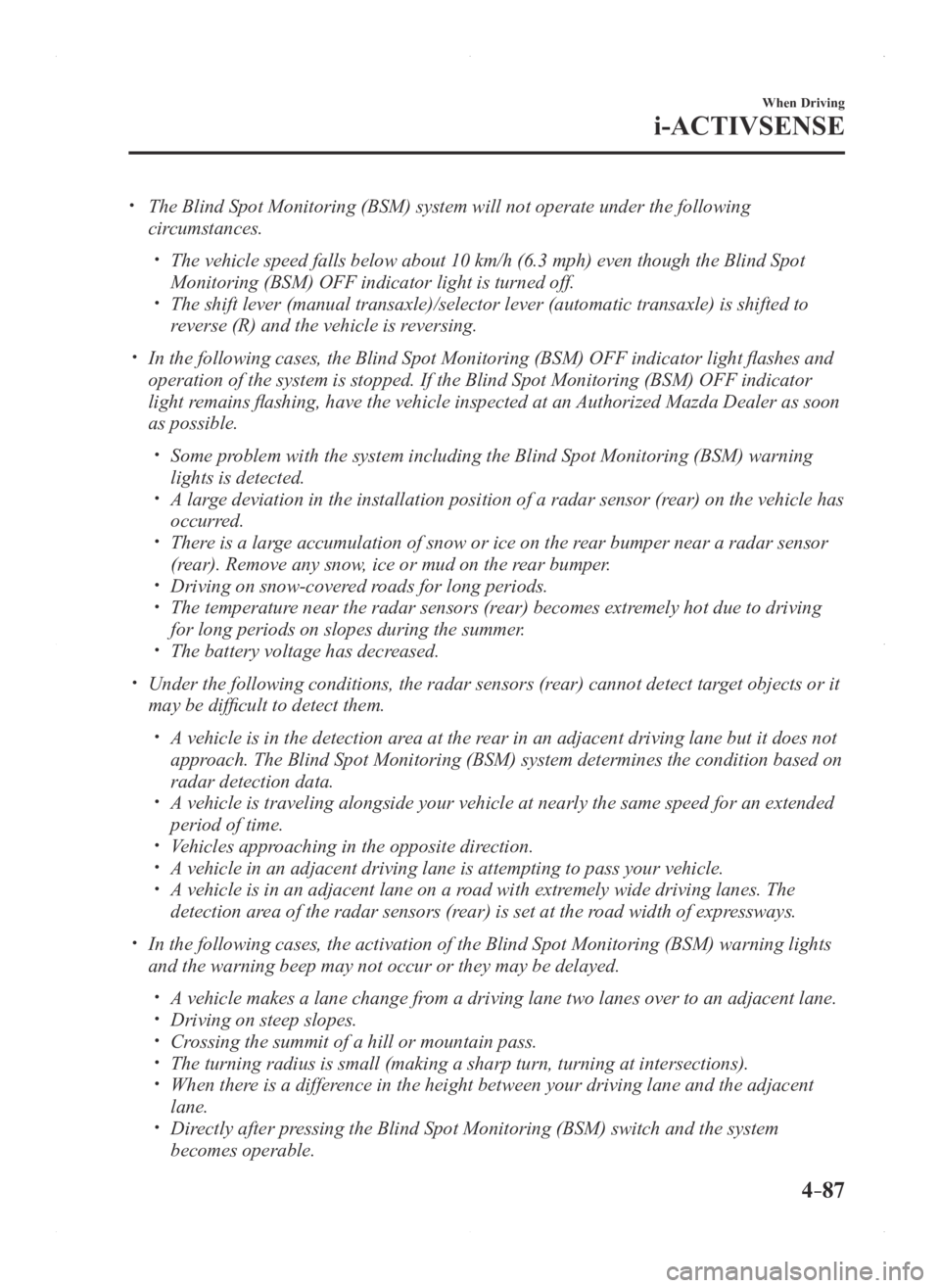
4–87
When Driving
i-ACTIVSENSE
The Blind Spot Monitoring (BSM) system will not operate under the foll\
owing
circumstances.
The vehicle speed falls below about 10 km/h (6.3 mph) even though the \
Blind Spot
Monitoring (BSM) OFF indicator light is turned off. The shift lever (manual transaxle)/selector lever (automatic transaxl\
e) is shifted to
reverse (R) and the vehicle is reversing.
In the following cases, the Blind Spot Monitoring (BSM) OFF indicator light flashes and
operation of the system is stopped. If the Blind Spot Monitoring (BSM)\
OFF indicator
light remains flashing, have the vehicle inspected at an Authorized Mazda Dealer as soon
as possible.
Some problem with the system including the Blind Spot Monitoring (BSM) warnin\
g
lights is detected. A large deviation in the installation position of a radar sensor (rear) on the vehicle has
occurred. There is a large accumulation of snow or ice on the rear bumper near a radar sensor
(rear). Remove any snow, ice or mud on the rear bumper. Driving on snow-covered roads for long periods. The temperature near the radar sensors (rear) becomes extremely hot due to driving
for long periods on slopes during the summer. The battery voltage has decr eased.
Under the following conditions, the radar sensors (r ear) cannot detect target objects or it
may be difficult to detect them.
A vehicle is in the detection area at the rear in an adjacent driving lane but it does not
approach. The Blind Spot Monitoring (BSM) system determines the condition \
based on
radar detection data.
A vehicle is traveling alongside your vehicle at nearly the same speed fo\
r an extended
period of time. Vehicles approaching in the opposite direction. A vehicle in an adjacent driving lane is attempting to pass your vehicle.\
A vehicle is in an adjacent lane on a road with extremely wide driving lanes. The
detection area of the radar sensors (rear) is set at the road width of expressways.
In the following cases, the activation of the Blind Spot Monitoring (BS\
M) warning lights
and the warning beep may not occur or they may be delayed.
A vehicle makes a lane change from a driving lane two lanes over to an adjacent lane. Driving on steep slopes. Crossing the summit of a hill or mountain pass. The turning radius is small (making a sharp turn, turning at intersecti\
ons). When there is a difference in the height between your driving lane and the adjacent
lane. Directly after pressing the Blind Spot Monitoring (BSM) switch and the system
becomes operable.
Mazda3_8FA4-EA-15G_Edition1.indb 872015/05/11 14:01:02
Page 216 of 598
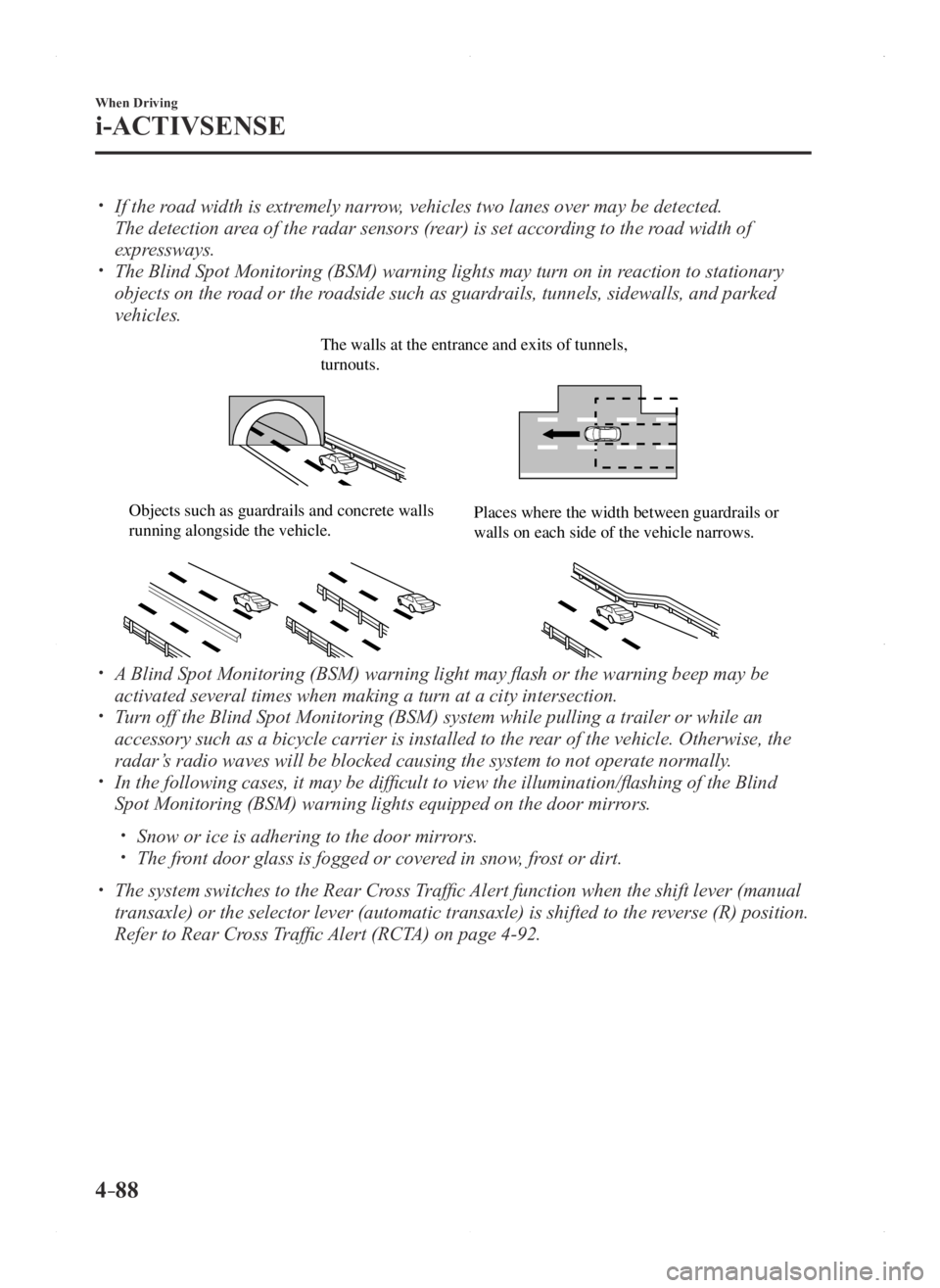
4–88
When Driving
i-ACTIVSENSE
If the road width is extremely narrow, vehicles two lanes over may be detected.
The detection area of the radar sensors (rear) is set according to the road width of
expressways.
The Blind Spot Monitoring (BSM) warning lights may turn on in reaction to stationary
objects on the road or the roadside such as guardrails, tunnels, sidewalls, and parked
vehicles.
The walls at the entrance and exits of tunnels, turnouts.
Objects such as guardrails and concrete walls running alongside the vehicle.Places where the width between guardrails or walls on each side of the vehicle narrows.
A Blind Spot Monitoring (BSM) warning light may flash or the warning beep may be
activated several times when making a turn at a city intersection. Turn off the Blind Spot Monitoring (BSM) system while pulling a trailer\
or while an
accessory such as a bicycle carrier is installed to the rear of the vehicle. Otherwise, the
radar’s radio waves will be blocked causing the system to not operate normally\
.
In the following cases, it may be difficult to view the illumination/flashing of the Blind
Spot Monitoring (BSM) warning lights equipped on the door mirrors.
Snow or ice is adhering to the door mirrors. The front door glass is fogged or covered in snow, frost or dirt.
The system switches to the Rear Cross Traffic Alert function when the shift lever (manual
transaxle) or the selector lever (automatic transaxle) is shifted to \
the reverse (R) position.
Refer to Rear Cross Traffic Alert (RCTA) on page 4-92.
Mazda3_8FA4-EA-15G_Edition1.indb 882015/05/11 14:01:03
Page 217 of 598
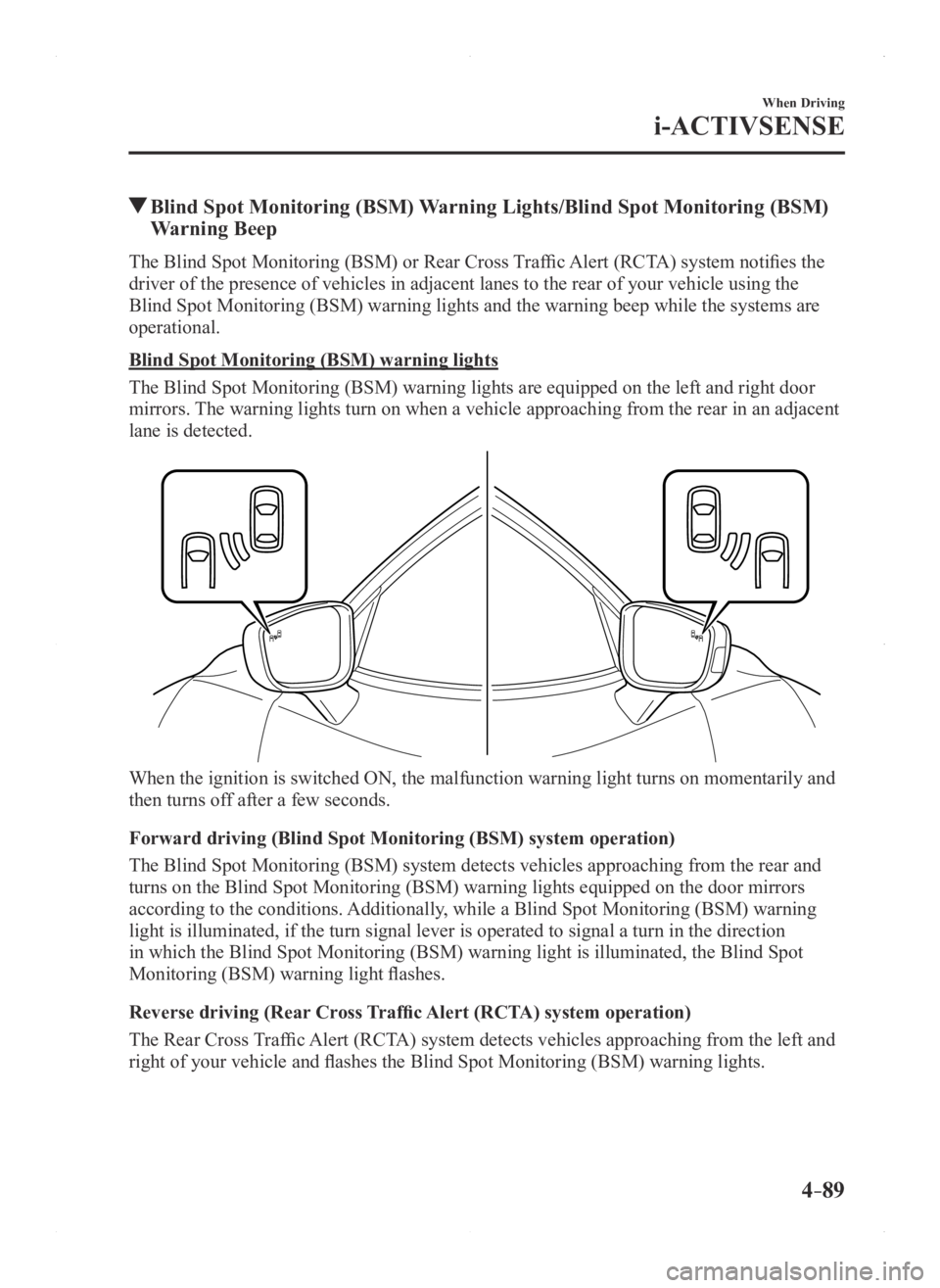
4–89
When Driving
i-ACTIVSENSE
Blind Spot Monitoring (BSM) Warning Lights/Blind Spot Monitoring (BSM)
Warning Beep
The Blind Spot Monitoring (BSM) or Rear Cross Traffic Alert (RCTA) system notifies the
driver of the presence of vehicles in adjacent lanes to the rear of your\
vehicle using the
Blind Spot Monitoring (BSM) warning lights and the warning beep while the systems are
operational.
Blind Spot Monitoring (BSM) warning lights
The Blind Spot Monitoring (BSM) warning lights are equipped on the left and right door
mirrors. The warning lights turn on when a vehicle approaching from the rear in a\
n adjacent
lane is detected.
When the ignition is switched ON, the malfunction warning light turns on momentarily and
then turns off after a few seconds.
Forward driving (Blind Spot Monitoring (BSM) system operation)
The Blind Spot Monitoring (BSM) system detects vehicles approaching from the rear and
turns on the Blind Spot Monitoring (BSM) warning lights equipped on the door mirrors
according to the conditions. Additionally, while a Blind Spot Monitoring (BSM) warning
light is illuminated, if the turn signal lever is operated to signal a t\
urn in the direction
in which the Blind Spot Monitoring (BSM) warning light is illuminated, the Blind Spot
Monitoring (BSM) warning light flashes.
Reverse driving (Rear Cross Traffic Alert (RCTA) system operation)
The Rear Cross Traffic Alert (RCTA) system detects vehicles approaching from the left and
right of your vehicle and flashes the Blind Spot Monitoring (BSM) warning lights.
Mazda3_8FA4-EA-15G_Edition1.indb 892015/05/11 14:01:03
Page 218 of 598
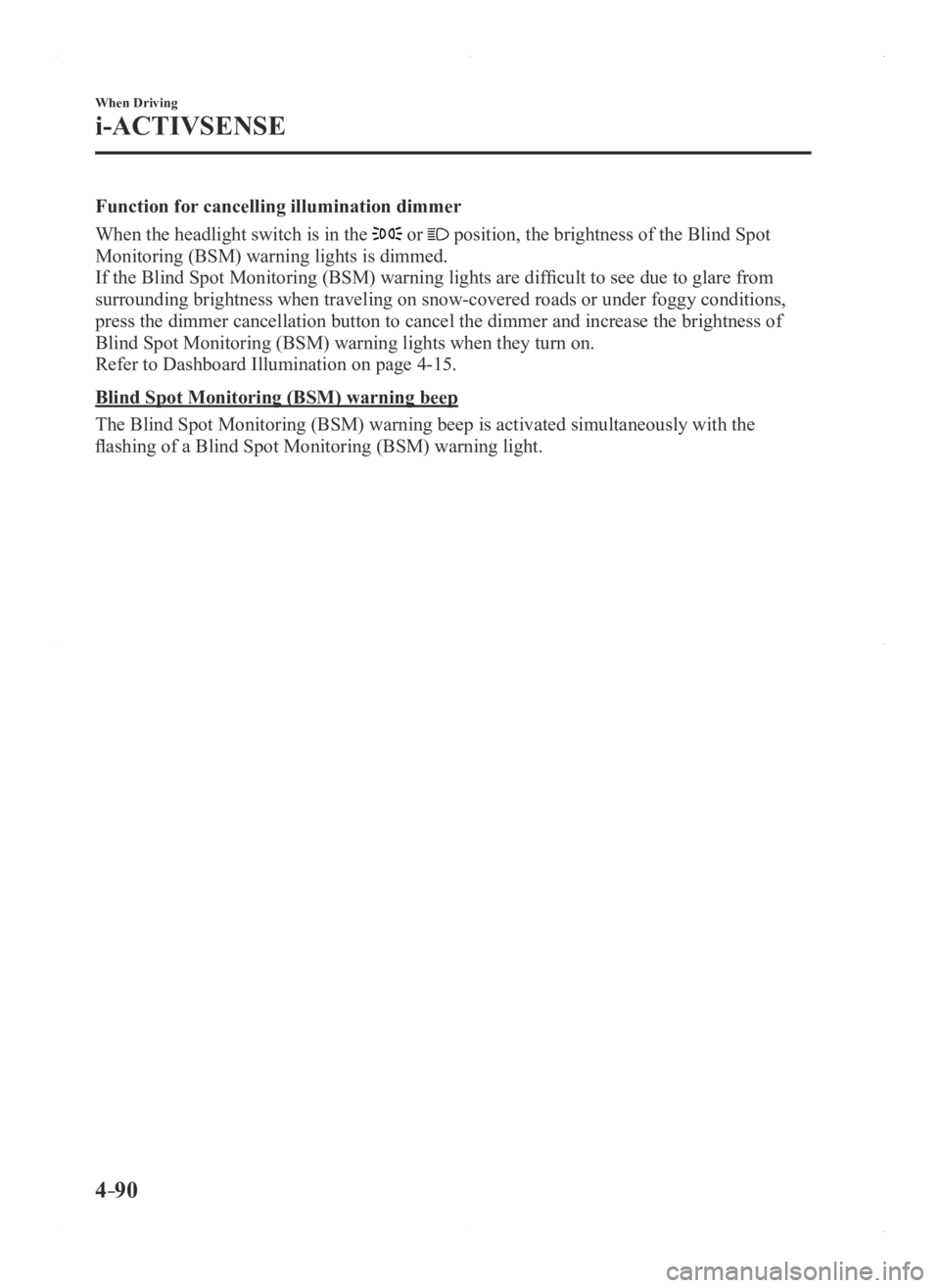
4–90
When Driving
i-ACTIVSENSE
Function for cancelling illumination dimmer
When the headlight switch is in the
or position, the brightness of the Blind Spot
Monitoring (BSM) warning lights is dimmed.
If the Blind Spot Monitoring (BSM) warning lights are difficult to see due to glare from
surrounding brightness when traveling on snow-covered roads or under fog\
gy conditions,
press the dimmer cancellation button to cancel the dimmer and increase t\
he brightness of
Blind Spot Monitoring (BSM) warning lights when they turn on.
Refer to Dashboard Illumination on page 4-15.
Blind Spot Monitoring (BSM) warning beep
The Blind Spot Monitoring (BSM) warning beep is activated simultaneously with the
flashing of a Blind Spot Monitoring (BSM) warning light.
Mazda3_8FA4-EA-15G_Edition1.indb 902015/05/11 14:01:03
Page 219 of 598
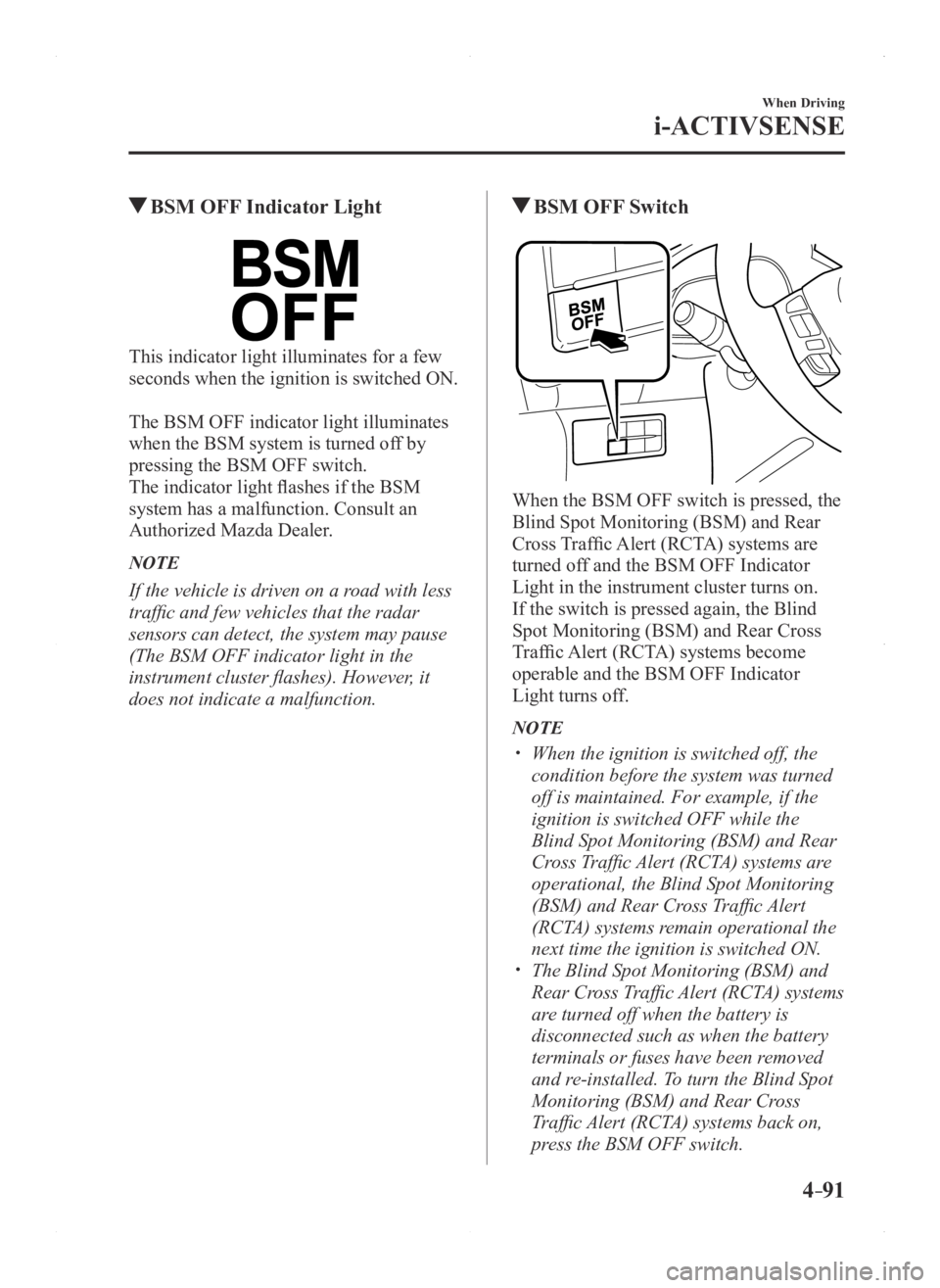
4–91
When Driving
i-ACTIVSENSE
BSM OFF Indicator Light
This indicator light illuminates for a few
seconds when the ignition is switched ON.
The BSM OFF indicator light illuminates
when the BSM system is turned off by
pressing the BSM OFF switch.
The indicator light flashes if the BSM
system has a malfunction. Consult an
Authorized Mazda Dealer.
NOTE
If the vehicle is driven on a road with less
traffic and few vehicles that the radar
sensors can detect, the system may pause
(The BSM OFF indicator light in the
instrument cluster flashes). However, it
does not indicate a malfunction.
BSM OFF Switch
When the BSM OFF switch is pressed, the
Blind Spot Monitoring (BSM) and Rear
Cross Traffic Alert (RCTA) systems are
turned off and the BSM OFF Indicator
Light in the instrument cluster turns on.
If the switch is pressed again, the Blind
Spot Monitoring (BSM) and Rear Cross
Traffic Alert (RCTA) systems become
operable and the BSM OFF Indicator
Light turns off.
NOTE
When the ignition is switched off, the
condition before the system was turned
off is maintained. For example, if the
ignition is switched OFF while the
Blind Spot Monitoring (BSM) and Rear
Cross Traffic Alert (RCTA) systems are
operational, the Blind Spot Monitoring
(BSM) and Rear Cross Traffic Alert
(RCTA) systems remain operational the
next time the ignition is switched ON.
The Blind Spot Monitoring (BSM) and
Rear Cross Traffic Alert (RCTA) systems
are turned off when the battery is
disconnected such as when the battery
terminals or fuses have been removed
and re-installed. To turn the Blind Spot
Monitoring (BSM) and Rear Cross
Traffic Alert (RCTA) systems back on,
press the BSM OFF switch.
Mazda3_8FA4-EA-15G_Edition1.indb 912015/05/11 14:01:04
Page 220 of 598

4–92
When Driving
i-ACTIVSENSE
Rear Cross Traffic Alert (RCTA)
The Rear Cross Traffic Alert (RCTA) system is designed to assist the driver in checking the
area to the rear of the vehicle on both sides while the vehicle is rever\
sing by alerting the
driver to the presence of vehicles approaching the rear of the vehicle.
The Rear Cross Traffic Alert (RCTA) system detects vehicles approaching from the left and
right sides of the vehicle while the vehicle is being reversed out of a \
parking space, and
notifies the driver of possible danger using the Blind Spot Monitoring (BSM) warning lights
and the warning buzzer.
Detection areas
Your vehicle
Rear Cross Traffic Alert (RCTA) operation
1. The Rear Cross Traffic Alert (RCTA) system operates when the shift lever (manual
transaxle) or the selector lever (automatic transaxle) is shifted to the reverse (R) position.
2. If there is the possibility of a collision with an approaching vehicle, the Blind
Spot Monitoring (BSM) warning light flashes and the warning beep is activated
simultaneously.
Mazda3_8FA4-EA-15G_Edition1.indb 922015/05/11 14:01:04